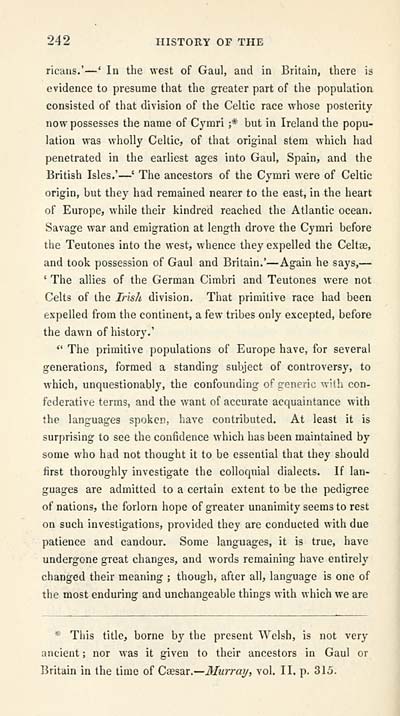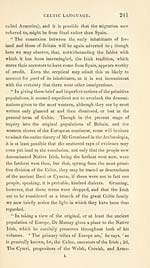Download files
Complete book:
Individual page:
Thumbnail gallery: Grid view | List view

242 HISTORY OF THE
ricaus.' — ' In the west of Gaul, and in Britain, there is
evidence to presume that the greater part of the population
consisted of that division of the Celtic race whose posterity
now possesses the name of Cymri ;* but in Ireland the popu-
lation was wholly Celtic, of that original stem which had
penetrated in the earliest ages into Gaul, Spain, and the
British Isles.' — ' The ancestors of the Cymri were of Celtic
origin, but they had remained nearer to the east, in the heart
of Europe, while their kindred reached the Atlantic ocean.
Savage war and emigration at length drove the Cymri before
the Teutones into the west, whence they expelled the Celtse,
and took possession of Gaul and Britain.' — Again he says, —
' The allies of the German Cimbri and Teutones were not
Celts of the Irish division. That primitive race had been
expelled from the continent, a few tribes only excepted, before
the dawn of history.'
" The primitive populations of Europe have, for several
generations, formed a standing subject of controvers}', to
which, unquestionably, the confounding of generic with con-
federative terms, and the want of accurate acquaintance with
the languages spoken, have contributed. At least it is
surprising to see the confidence which has been maintained by
some who had not thought it to be essential that they should
first thoroughly investigate the colloquial dialects. If lan-
guages are admitted to a certain extent to be the pedigree
of nations, the forlorn hope of greater unanimity seems to rest
on such investigations, provided they are conducted with due
patience and candour. Some languages, it is true, have
undergone great changes, and words remaining have entirely
changed their meaning ; though, after all, language is one of
the most enduring and unchangeable things with which we are
* This title, borne by the present Welsh, is not very
ancient ; nor was it given to their ancestors in Gaul or
Britain in the time of Caesar.— iJ/wrray, vol. II. p. 315.
ricaus.' — ' In the west of Gaul, and in Britain, there is
evidence to presume that the greater part of the population
consisted of that division of the Celtic race whose posterity
now possesses the name of Cymri ;* but in Ireland the popu-
lation was wholly Celtic, of that original stem which had
penetrated in the earliest ages into Gaul, Spain, and the
British Isles.' — ' The ancestors of the Cymri were of Celtic
origin, but they had remained nearer to the east, in the heart
of Europe, while their kindred reached the Atlantic ocean.
Savage war and emigration at length drove the Cymri before
the Teutones into the west, whence they expelled the Celtse,
and took possession of Gaul and Britain.' — Again he says, —
' The allies of the German Cimbri and Teutones were not
Celts of the Irish division. That primitive race had been
expelled from the continent, a few tribes only excepted, before
the dawn of history.'
" The primitive populations of Europe have, for several
generations, formed a standing subject of controvers}', to
which, unquestionably, the confounding of generic with con-
federative terms, and the want of accurate acquaintance with
the languages spoken, have contributed. At least it is
surprising to see the confidence which has been maintained by
some who had not thought it to be essential that they should
first thoroughly investigate the colloquial dialects. If lan-
guages are admitted to a certain extent to be the pedigree
of nations, the forlorn hope of greater unanimity seems to rest
on such investigations, provided they are conducted with due
patience and candour. Some languages, it is true, have
undergone great changes, and words remaining have entirely
changed their meaning ; though, after all, language is one of
the most enduring and unchangeable things with which we are
* This title, borne by the present Welsh, is not very
ancient ; nor was it given to their ancestors in Gaul or
Britain in the time of Caesar.— iJ/wrray, vol. II. p. 315.
Set display mode to: Large image | Transcription
Images and transcriptions on this page, including medium image downloads, may be used under the Creative Commons Attribution 4.0 International Licence unless otherwise stated. ![]()
| Early Gaelic Book Collections > Blair Collection > History of the Celtic language > (248) |
|---|
| Permanent URL | https://digital.nls.uk/76181337 |
|---|
| Description | A selection of books from a collection of more than 500 titles, mostly on religious and literary topics. Also includes some material dealing with other Celtic languages and societies. Collection created towards the end of the 19th century by Lady Evelyn Stewart Murray. |
|---|
| Description | Selected items from five 'Special and Named Printed Collections'. Includes books in Gaelic and other Celtic languages, works about the Gaels, their languages, literature, culture and history. |
|---|

